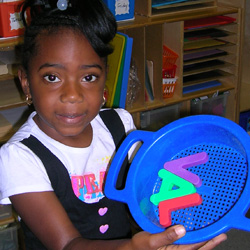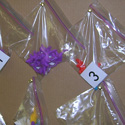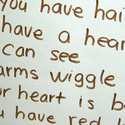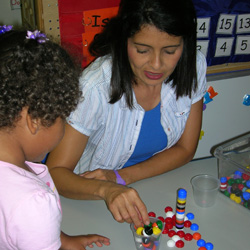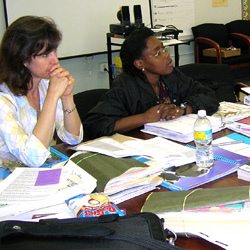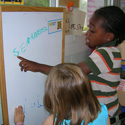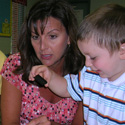Preschool in Florida
Voters in Florida made a bold move in 2002. They amended their state constitution to give every 4-year-old the right to attend preschool for free.
But as the state races to set up enough preschools to meet demand, experts say Florida is setting up a lot of preschools that aren't very good.
Part of the problem is money. The state spends about $2,500 per student per year, while the famous Perry Preschool spent the equivalent of $10,000.
But part of the problem, experts say, is that many teachers don't know what research says about how to teach preschool. So they're not doing it right.
"We've worked with teachers who were in front of the room all the time," says Jo Hudson, who heads a program trying to change preschools in Florida. "She was doing all the talking all the time [and] her kids were sitting on the floor, all the time."
Hudson says she's seen teachers giving children lots of worksheets, making them trace their names over and over again. And she says this is not what preschool should be like. Research from the Perry Preschool and other early childhood programs shows that there are better ways to teach young children.
Hudson and her colleagues at the Northeast Florida Educational Consortium got a $4 million grant from the federal government and they are using the money to train preschool teachers. Their goal is to help teachers better understand why preschool is important, and what the research says about what works.
"Preschool teachers have generally been ignored," says Hazel Jones, an early education expert at the University of Florida and an adviser to the teacher-training program. "You know, 'Oh, it's just preschool.'"
And she says that's a big mistake because when it comes to the gains children get from preschool, research shows that teachers really matter. And she says most teachers in Florida get very little training. They're handed a curriculum guide and they're pretty much on their own.
"We just had a curriculum and we just went about doing it,' says Faye Wright, one of the teachers in the program. "Now we pay more attention to what we teach and why we teach it. When you know why you [are] doing something, you'll do it better," she says.
The teacher-training program is called REACH. It's focused on four poor school districts in northeastern Florida. The program has been in place for two years. Here's how it works: Several times a year all of the teachers in the program come together for "institutes" where they learn about the latest research on preschool, child development, learning theory - things like that. There are 14 teachers in the program. The teachers are paid a stipend. They also get money to buy additional books and materials for their classrooms.
In addition to the institutes where they learn about the research on preschool, teachers work together in small groups throughout the school year. Each group is assigned a full-time coach. Gina Hendrick works with four preschool teachers in Palatka - a small city where a third of the population lives below the poverty level.
"I'm in the classrooms every day," says Hendrick. "I observe, I model. We debrief at the end of day - 'How did that lesson go? What did you think? How did the children do with this?'"
Hendrick is a former kindergarten teacher. She says she never got this kind of training and support. And she thinks preschool teachers need it now more than ever - because they are under increasing pressure to make sure children master certain basic skills. And a lot of the teachers don't know how to do that without standing in front of the children and telling them what to do.
"Teachers have fear that they're not going to get these kids where they need to be," says Jo Hudson. "So they follow the curriculum." They do what the book tells them to do, and that's it. "I think because of that, students become very unmotivated about learning. Teachers aren't motivated, so kids aren't motivated."
Hudson's colleague Sandy Lewis agrees. "So often [teachers] feel like when we try and teach skills it's a sit-down, teacher's going to be up there lecturing, pouring this knowledge into the children."
But she says it shouldn't be that way. "We can teach children skill-based literacy all through developmentally appropriate play. And the children don't even realize that they're learning these skills! It's fun, hands-on, interesting, interactive."
Hands-on learning is a big focus of this program. Research shows that young children learn more from active experiences than from worksheets and formal lessons. And so Lewis and Hudson are encouraging the teachers to shake things up. Put children in small groups, let them do more on their own. And fill the classroom up with things that children can touch and use and interact with. Puzzles, books, toys, games, costumes, paper, crayons - there should be a lot of stuff, all over the place, so that wherever a child goes in a classroom, he or she encounters an opportunity to explore, to play, to pretend.
"Now we have seven centers," says teacher Faye Wright. "Seven identified areas that teach children different things." There's a writing center with paper and pencils and games to practice writing, a reading center, a construction center - even a science center with microscopes and measuring cups.
"We didn't have that before," says Wright. They didn't really think about teaching science. It was write your name, know your numbers and your ABCs. Then take a break, go play. And when the children went off to play, teachers went to their desks to plan lessons. But what the teachers say they're learning is that children learn best through play, and through the interactions they have with each other, and their teachers.
"So now when they go to centers, we are in the centers with them," says Wright. "We have been taught we need to be everywhere that they are."
Coach Gina Hendrick says teachers need to get down on the floor, get involved. And talk to the children. "Extend the conversation with them," she says. "Get them to hear new words and get them to say new words, ask them questions, take their lead. If they're interested in a topic, go ahead and talk about that topic."
Getting the children to talk - and talk and talk - is the main goal. "In all of our [training] we focus in on language and language development," says REACH coordinator Jo Hudson. Expanding children's vocabulary, encouraging them to speak up and ask questions - Hudson says these are the most important things a preschool teacher can do.
And it's not what they were doing.
"Sometimes [the kids] would talk too much and we were like - 'Can you all just be quiet!'" says teacher Jill Lynady. She thought a good classroom was a quiet classroom, so she spent a lot of time with her finger on her lips, gesturing to the kids to shush.
Her fellow teacher Faye Wright giggles. "Like at lunch, I used to feel like they shouldn't talk while they're eating. But now, we are to hold conversations about - what are you eating, why are you eating, do you like that?"
Wright says what she's learning in this program is how to give up some control. On the bottom of her daily lesson plan is a note in bold: "This schedule is a guideline and will be flexible with the needs of the children!"
In many ways that sums up the main message of the REACH program: Loosen up, follow the lead of the kids.
Another goal of the program is to remind teachers that preschool should be fun. It should get children excited about coming to school. Teacher Kutina Smith says she used to be all business in the classroom, kind of like a drill sergeant. And she was skeptical about the idea of sending children off to centers to learn things on their own.
"I thought if I gave these kids all this space, it was going to be chaos."
And it wasn't.
"Now I'm letting the kids go off and deal with things themselves, having them figure things out. They're doing it themselves and they're teaching one another how to do something," she says.
"You can see their expression on their face saying, 'This is me, I'm doing this myself. Teacher didn't help me do this.' And they're proud, even if it's just a line [on a piece of paper]. They are proud of that line, and they want to stick it to the wall. And that makes them want to go back over there and try to make something a little bit more, which is what we want. And by drilling them, they get away from it. It makes them not want to do it," she says.
Smith says she thinks her students are learning more now. "They come here more creative than we are really," she says. "And they soak in everything very quickly."
"It's raised my expectations of what I want them to do by the end of the year," says teacher Myrtle Hill. "Compound words, syllables." She says she's learned that if you never let children do anything on their own, they never surprise you with what they can do.
"I struggle with letting go and not taking control of everything," she admits with a laugh. She says when teaching children to write her impulse was to grab their hands and do it for them. "We had color sheets and we had dotted letters, you know, and 'you write on the line, this is what you do.'"
But Hill says the REACH program has encouraged her to get away from all the structure. "Just supply them with the materials and let them begin to do it, at their own pace." She says rather than grabbing their hands and showing them exactly what to do, now she spends a lot of time modeling the act of writing. "Demonstrating it, writing in front of them."
Hill says she writes stories about herself to show the kids: This is what you can do. She encourages the children to write about themselves, anything they want, and if it's just a scribble, that's fine. "Never before have my children been excited about writing," she says.
And she puts everything they write up on the walls, even if she has no idea what it says. The REACH trainers "like everything displayed," she says. "So we got all this [stuff] hanging all over the room. And [the children] are so proud. It means something to them. The stuff that we bought at the teacher store doesn't mean anything to them. It just looks nice to us."
Hill says the children are more excited about books now, too. "They have a love for books more than any other year I have ever taught," she says. "Why is that?" she asks herself. "I guess because we have more of an emphasis on books and we have so many books." This is where that extra money for materials comes in. The REACH classrooms have not just more books, but books that the teachers have personally chosen. "They see us more excited" about books now, she says. "And I guess it rubs off."
"Before, you could pick up a book and it was kind like, 'Oh gosh, here we go again,'" says teacher Jill Lynady. Reading was sort of a chore, something all the teachers knew they were supposed to do, but not really how or why they were supposed to do it. "You'd just read a book and the book was over and you'd go on to something else. Maybe we might've talked a little bit about it and then it was like, 'Okay, we got to move on.'"
But the REACH program has helped her understand that talking about the books is the main point. Get the kids to ask questions, give their opinions. Get them thinking. That's more of a focus now, trying to understand what the children are curious about. "Now it's like they know that you're going to ask them questions, so they get into the books. They know they can raise their hands and ask you something or tell you something about the book," she says. "I think it has a bigger impact on them."
"Language, literacy, getting them to talk - that's what it's all about," says teacher Faye Wright. "What we want the kids to learn is different now."
She used to think the point of preschool was for children to learn their numbers, letters, colors and shapes. She says those things are important, but she realizes now that children can learn much more than that. They can begin to learn how to learn - to think, ask questions, express themselves.
"And we are getting data," says teacher Kutina Smith, referring to the tests that children take to measure their progress in this program. "And I must say my data shows growth. And I'm proud of my babies, every one of them."
Smith's especially impressed because the children in her class are considered developmentally delayed. They're headed for special education, just like the Perry Preschool children were. And she says the REACH program has opened her eyes to how much her students can learn - more than she thought they could. Two of the children in her class made so much progress that they went into regular kindergarten classes this year. They are no longer in special education.
And early results show that all of the students in this program have made, on average, significant gains on tests of early language and literacy skills. And they are ahead of their peers who went to preschools that did not have the REACH program in place. In other words, results so far show that children are learning more in the classrooms where teachers receive REACH training.
This is exciting news for the people running the REACH program. Test score gains mean everything. That's how programs succeed or fail these days. You can't claim success without measurable results.
And the gains that students make on tests measure real progress on meaningful skills, says Lynda Hayes, one of the expert advisers to the REACH program. "We need to ensure that every child leaves preschool able to write their name, that every child leaves preschool being able to recognize a majority of the letters, that every child leaves preschool with some sensitivity to the sounds of language." These are crucial skills that help children learn to read and start them off on a good path in school, she says.
But she thinks there's probably too much focus on testable skills, and not enough on what else children need to learn in school. We need to make sure that every child "leaves preschool able to make sense of the world," she says. "To have conversations about the world, to wonder about the world, to reason about the world."
She thinks these are essential skills. "Even if you work in a factory today, you've got to be able to make sense of what you're doing and you've got to be able to interpret manuals and collaborate and problem solve," she says. Hayes says she thinks children should be learning these skills in preschool - and all the way up through school. And they're not.
"We are at a point in our nation where we have to completely reinvent what does it mean to go to school," she says. "What should be happening there? What do our children need to know and be able to do? We're at a place where we have to really reconsider that."
Hayes and her colleague Hazel Jones think one of the biggest effects of the REACH program may be the way it's changing how school principals think about preschool. When the program began, says Jones, the principals' attitude was "whatever you all want to do, it's fine with us." She says they didn't seem to think preschool was important. But now they're seeing the test score gains, and they're getting interested. "They're coming to the meetings, asking us what we're teaching the teachers."
As more and more preschool classes are set up in public schools - in Florida and across the country - Jones and Hayes say preschool teachers have an opportunity. Now, they're in the same building with the principal, they're across the hall from the kindergarten, they're in the lunchroom with the first grade. And preschool teachers have a chance to show principals and elementary school teachers what they have learned about the importance of hands-on learning and how to help children get excited about school.
"They are now able to articulate this to others," says Jones.
The REACH program has "put the spotlight on how important their work is," says Hayes. "They're much more focused on what it is they're trying to accomplish with their students because of what they know from the research."
Teacher Faye Wright agrees. "Some people might think we probably brag on the REACH program a lot. But it's just amazing what we've learned."
Back to Early Lessons.


